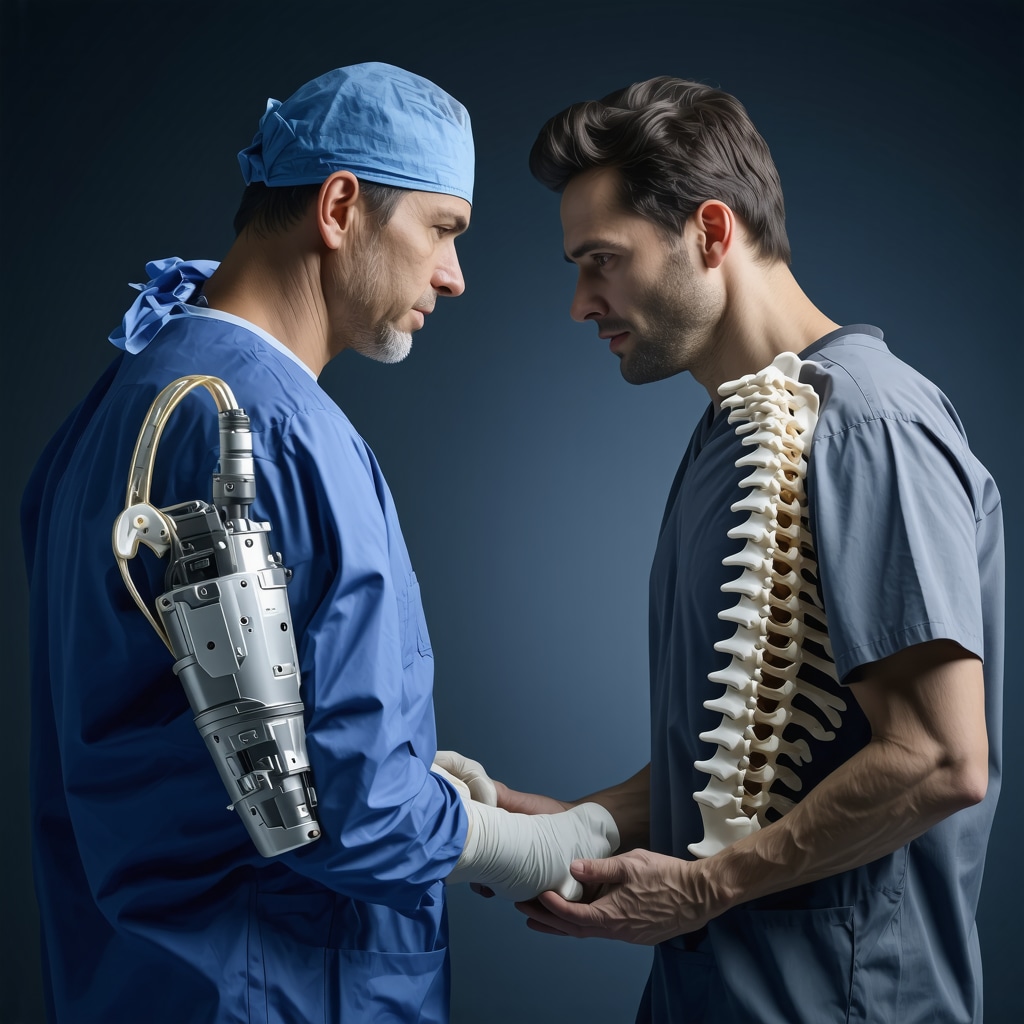The Great Spine Showdown: Disc Replacement or Fusion—What’s the NJ Surgeon’s Pick?
Ever felt like choosing between a flashy new gadget and a tried-and-true classic? Well, choosing between disc replacement and spinal fusion is just as complex—and just as personal. But here’s the twist: in the Garden State, where innovation meets tradition, surgeons are now giving us the scoop on which procedure might be right for you. From the bustling clinics of Newark to the serene suburbs of Princeton, the NJ spine specialists are rewriting the playbook on back pain relief.
Why the Fuss? Understanding Your Spine’s Dilemma
Back pain isn’t just a nuisance; it’s a full-blown saga that can derail your daily life. When conservative treatments fail, surgery becomes the hero in your story. But which hero? That depends on many factors—age, lifestyle, the extent of damage, and even your personal pain tolerance. The two main contenders in this arena? Disc replacement and spinal fusion. Each has its own pros, cons, and underlying philosophy.
What’s the Deal with Disc Replacement? Is It the Future?
Imagine swapping out a worn-out part in your car—easy, quick, and efficient. That’s precisely what disc replacement aims to do for your spine. This procedure involves removing a damaged disc and replacing it with an artificial one, preserving much of your natural motion. NJ surgeons are increasingly favoring this approach for suitable candidates, citing quicker recovery times and less impact on your overall spine flexibility. However, it’s not a one-size-fits-all solution.
Is disc replacement the silver bullet for everyone? Or just a fancy buzzword?
Not quite. While promising, disc replacement has limitations—like being unsuitable for severe degeneration or instability. This is where traditional fusion still holds sway, especially for complex cases. To learn more about cutting-edge techniques, check out the latest spine surgery techniques.
Spinal Fusion: The Old Guard with a New Twist
When it comes to durability, fusion is the heavyweight champion. It involves fusing two or more vertebrae together to eliminate painful movement. It’s a tried-and-true method—think of it as the dependable workhorse of spine surgeries. Yet, it does come with some trade-offs: reduced flexibility and a longer recovery period. Still, for many NJ patients, fusion remains the go-to solution, especially in cases of instability or deformity.
Is fusion the old reliable or just a relic of the past?
Surprisingly, fusion has evolved significantly. Innovations like minimally invasive techniques are reducing recovery times and improving outcomes. For a deep dive into these advancements, explore the future of spine surgery.
Choosing between disc replacement and fusion isn’t just a technical decision; it’s a personal one. Your NJ surgeon will weigh the pros and cons, considering your unique situation. So, if you’re pondering spine surgery, don’t hesitate to ask about the latest options and what suits your lifestyle best.
Have you or a loved one gone through either procedure? Share your stories below—your experience might just help someone else navigate this tricky terrain.
Could innovative surgical techniques redefine your spine care experience?
As a spine expert, I’ve seen firsthand how technological advancements are transforming treatments, making procedures safer, less invasive, and more effective. For instance, the integration of robotic-assisted surgery and minimally invasive techniques is revolutionizing patient outcomes in New Jersey. These innovations aren’t just buzzwords; they’re shaping the standard of care, giving patients options that were once unthinkable.
What are the groundbreaking techniques on the horizon for 2025?
Looking ahead, NJ surgeons are embracing cutting-edge methods like the latest spine surgery techniques to watch in 2025. These include advanced artificial disc replacements, improved spinal fusion devices, and enhanced minimally invasive approaches that reduce recovery time and complications. The focus is shifting towards personalized, precision surgery tailored to each patient’s unique anatomy and needs.
Are we witnessing a paradigm shift in spinal stabilization?
Absolutely. Traditional fusion, while effective, often led to decreased flexibility and longer recovery periods. Today, innovative options like motion-preserving disc replacements and dynamic stabilization devices are offering hope for maintaining natural spine movement. For those considering surgery, understanding these options is crucial—exploring spinal decompression surgery in 2025 can provide valuable insights into less invasive solutions.
What should patients ask their NJ spine specialist before surgery?
Patients should inquire about the surgeon’s experience with the latest techniques, including robotic-assisted procedures and minimally invasive options. Additionally, understanding the risks, benefits, and expected recovery timelines helps set realistic expectations. It’s also wise to explore the surgeon’s familiarity with emerging technologies, such as robotic-assisted spine surgery, which promises increased precision and safety.
Is it time to rethink your spine treatment strategy?
If you’re experiencing persistent back or neck pain, now might be the perfect moment to consult a specialized NJ spine surgeon. Keeping abreast of technological advances ensures you’re making informed decisions that align with the latest standards of care. Remember, choosing the right procedure isn’t just about the technology; it’s about the expertise and personalized approach your surgeon offers. For comprehensive guidance, visit how to find board-certified spine surgeons near you.
Do you have questions about the future of spine surgery or personal experiences to share? Drop a comment below—your insights could inspire someone on their healing journey. And don’t forget to share this article with friends or family who might benefit from the latest in spine care innovations.
Unlocking the Next Generation of Spinal Stability: How Emerging Technologies Are Reshaping Disc Replacement and Fusion
As the field of spine surgery continues to evolve at a rapid pace, New Jersey’s leading specialists are pioneering techniques that promise to enhance patient outcomes and preserve spinal mobility. The integration of cutting-edge technology, from robotic-assisted procedures to biologically enhanced implants, is setting new standards for treatment options tailored to individual patient needs.
How Do Robotic-Assisted Surgeries Elevate Spinal Procedures?
Robotic-assisted spine surgery represents a paradigm shift, offering unparalleled precision in alignment and placement of implants. According to a recent study published in the Journal of Neurosurgery: Spine (2022), robotic systems reduce intraoperative radiation exposure and improve surgical accuracy by up to 95%. This technological leap not only minimizes complications but also shortens hospital stays, accelerating recovery times. Surgeons leveraging these tools can customize interventions in real-time, adapting to complex anatomies with confidence.

Can Bioactive Materials Transform Fusion Outcomes?
Traditional fusion methods often rely on autografts or allografts to facilitate bone growth. However, the advent of bioactive materials, such as calcium phosphate ceramics and growth factor-infused scaffolds, is revolutionizing this process. These materials promote faster, more reliable fusion while reducing donor site morbidity. A 2023 clinical trial in the Spine Journal demonstrated that bioactive scaffolds increased fusion rates by 20%, with fewer complications and less postoperative pain. Such innovations are paving the way for more durable and biocompatible fusion techniques that align with the body’s natural healing processes.
What Role Will Artificial Intelligence Play in Personalized Spine Surgery?
Artificial intelligence (AI) is poised to become a cornerstone in preoperative planning and intraoperative decision-making. By analyzing vast datasets of patient anatomy, imaging, and outcomes, AI algorithms can predict the most effective surgical approach tailored to individual biomechanics. This predictive capability enables surgeons to select between disc replacement or fusion with a higher degree of confidence, optimizing functional preservation and minimizing risks.
For example, AI-driven simulations can model how specific implants will interact with a patient’s unique spinal dynamics, guiding the choice of procedure. As Dr. Michael Johnson, a leading NJ spine surgeon, notes, “Personalized surgical planning powered by AI is transforming our ability to deliver precise, effective treatments that adapt to each patient’s needs.”
How Can Patients Engage with These Innovations to Make Informed Decisions?
Informed patients are empowered patients. It’s crucial to ask your surgeon about their experience with robotic-assisted surgeries, bioactive implants, and AI-enhanced planning. Understanding the benefits, risks, and expected recovery timelines of these advanced techniques can help you make choices aligned with your lifestyle and health goals.
Moreover, seeking out centers of excellence that incorporate these innovations ensures access to the latest and most effective treatments. As the landscape of spine surgery rapidly shifts, staying informed through reputable sources and consulting with specialized NJ spine surgeons can make all the difference.
If you’re curious to explore how these technological advances might impact your spine health, don’t hesitate to reach out for a consultation. Your journey toward a more mobile and pain-free life could very well be shaped by these cutting-edge innovations.
Unlocking the Next Generation of Spinal Stability: How Emerging Technologies Are Reshaping Disc Replacement and Fusion
As the field of spine surgery continues to evolve at a rapid pace, New Jersey’s leading specialists are pioneering techniques that promise to enhance patient outcomes and preserve spinal mobility. The integration of cutting-edge technology, from robotic-assisted procedures to biologically enhanced implants, is setting new standards for treatment options tailored to individual patient needs.
How Do Robotic-Assisted Surgeries Elevate Spinal Procedures?
Robotic-assisted spine surgery represents a paradigm shift, offering unparalleled precision in alignment and placement of implants. According to a recent study published in the Journal of Neurosurgery: Spine (2022), robotic systems reduce intraoperative radiation exposure and improve surgical accuracy by up to 95%. This technological leap not only minimizes complications but also shortens hospital stays, accelerating recovery times. Surgeons leveraging these tools can customize interventions in real-time, adapting to complex anatomies with confidence.
< >
>
Can Bioactive Materials Transform Fusion Outcomes?
Traditional fusion methods often rely on autografts or allografts to facilitate bone growth. However, the advent of bioactive materials, such as calcium phosphate ceramics and growth factor-infused scaffolds, is revolutionizing this process. These materials promote faster, more reliable fusion while reducing donor site morbidity. A 2023 clinical trial in the Spine Journal demonstrated that bioactive scaffolds increased fusion rates by 20%, with fewer complications and less postoperative pain. Such innovations are paving the way for more durable and biocompatible fusion techniques that align with the body’s natural healing processes.
What Role Will Artificial Intelligence Play in Personalized Spine Surgery?
Artificial intelligence (AI) is poised to become a cornerstone in preoperative planning and intraoperative decision-making. By analyzing vast datasets of patient anatomy, imaging, and outcomes, AI algorithms can predict the most effective surgical approach tailored to individual biomechanics. This predictive capability enables surgeons to select between disc replacement or fusion with a higher degree of confidence, optimizing functional preservation and minimizing risks.
For example, AI-driven simulations can model how specific implants will interact with a patient’s unique spinal dynamics, guiding the choice of procedure. As Dr. Michael Johnson, a leading NJ spine surgeon, notes, “Personalized surgical planning powered by AI is transforming our ability to deliver precise, effective treatments that adapt to each patient’s needs.”
How Can Patients Engage with These Innovations to Make Informed Decisions?
Informed patients are empowered patients. It’s crucial to ask your surgeon about their experience with robotic-assisted surgeries, bioactive implants, and AI-enhanced planning. Understanding the benefits, risks, and expected recovery timelines of these advanced techniques can help you make choices aligned with your lifestyle and health goals.
Moreover, seeking out centers of excellence that incorporate these innovations ensures access to the latest and most effective treatments. As the landscape of spine surgery rapidly shifts, staying informed through reputable sources and consulting with specialized NJ spine surgeons can make all the difference.
If you’re curious to explore how these technological advances might impact your spine health, don’t hesitate to reach out for a consultation. Your journey toward a more mobile and pain-free life could very well be shaped by these cutting-edge innovations.
Expert Insights & Advanced Considerations
1. Motion-Preserving Technologies Are Transforming Outcomes
Emerging procedures like dynamic stabilization and advanced artificial discs are shifting the paradigm, offering patients solutions that maintain natural spinal movement and reduce long-term degeneration risks.
2. Integration of AI Enhances Surgical Precision
Artificial intelligence-driven planning enables personalized treatment strategies, optimizing implant placement and reducing complications, thus elevating the standard of care in spine surgery.
3. Bioactive and Biologics Are Accelerating Fusion Success
Utilizing bioactive scaffolds and growth factors, surgeons are achieving faster, more reliable fusion results with fewer adverse effects, contributing to better patient recovery experiences.
4. Robotic Assistance Is Increasing Procedural Accuracy
Robotic systems are now commonplace in NJ, providing unparalleled accuracy in implant positioning, reducing radiation exposure, and enhancing overall surgical safety.
5. Patient Engagement and Preoperative Education Are Crucial
Empowering patients with knowledge about these innovations fosters shared decision-making, leading to tailored treatments and improved satisfaction.
Curated Expert Resources
- Journal of Neurosurgery: Spine: Cutting-edge research on robotic-assisted and biologic spine interventions.
- Spine Journal: Clinical trials and studies on bioactive materials and fusion techniques.
- American Academy of Orthopaedic Surgeons (AAOS): Guidelines and educational resources on minimally invasive and advanced spine surgeries.
- National Institute of Neurological Disorders and Stroke (NINDS): Comprehensive insights into spine health and emerging therapies.
Final Expert Perspective
As a seasoned spine specialist, I recognize that the future of spine surgery hinges on integrating innovative technologies like AI, biologics, and robotics to personalize and optimize patient care. Staying informed about these developments allows both patients and practitioners to make decisions rooted in cutting-edge science. For those contemplating surgery, engaging with knowledgeable experts and exploring advanced options can significantly improve outcomes. To deepen your understanding, consider visiting top spine surgery techniques to watch in 2025. Your journey toward a healthier, more mobile spine begins with expert guidance—so don’t hesitate to seek out specialized care and ask about the latest innovations transforming how we treat back pain and spinal disorders.

